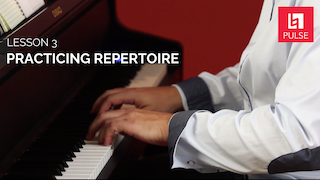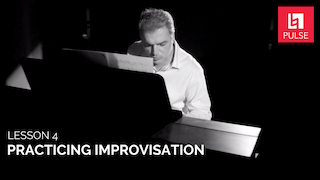
LESSON 2: Practicing Technique
Featuring: Leo Blanco, Professor at Berklee College of Music
In this lesson, you will discover the secret to having an effective practice session by mapping out a clear direction for your entire practice session. Leo Blanco will also guide you through best practices for warming-up while practicing your technique in creative and constructive ways.
Each mini-lesson is built upon the content of each video. Specific instructions are provided on how to work with students in class and assessments for each lesson map directly to each lesson’s stated outcomes. Access free resources to enhance this lesson by joining Berklee PULSE.
Outcomes:
- Identify the three parts of a practice session
- Describe why it is important to warm up and practice technique
- Identify what techniques to practice based on your goals and repertoire
- Establish a practice routine by practicing daily and tracking your practice in your PULSE Practice Journal
Materials:
- Computer with a browser such as Chrome, Safari or Firefox, to access the Berklee PULSE website
- Projector, PA system
- Video 2: Assessment Video Key Points Scavenger Hunt (pdf)
- PULSE Practice Journal (pdf)
- Practicing Technique, Video Transcript (pdf)
INSTRUCTIONAL ACTIVITY IDEAS
Exposition of Material
1. Teacher provides a very brief introduction (3 minutes) to the video.
2. Teacher shows video.
Identifying Key Concepts and Terms
3. After the video, provide the students with a handout Video 2: Assessment Video Key Points Scavenger Hunt that helps them find the key points in the video. Go over each of the questions out loud in class.
4. Show the video a second time. This time, students watch the video and take notes on their handout.
5. Teacher then provides a transcript of the video and gives students 5-7 minutes to complete the handout.
6. Students submit the handout, and then move on to part 2 of the lesson, which is to create a practice journal.
Identifying Appropriate Technique Exercises
7. Teacher: “As we learned, technique should begin each of your practice sessions and should be about ¼ to ⅓ of your total practice time. This is the part of the session where you warm up your playing muscles, and then you move on to specific skills. Always, start slowly, and move into faster or more challenging techniques.
8. Your practice plan, and what warmups and technique exercises you will practice, depends on your goals. Work with your teacher to decide what will help you most at this point in your musical development.
9. Given the amount of time you devoted to practice in Lesson 1, now write down how much time you will devote to warmup and technique.
10. Working with your teacher, write down a warmup/technique routine you should use to start each practice session. This may include long tones, scales, rhythmic exercises, or other—it all depends on your instrument, your teacher, your goals, and where you are toward reaching them.
Lesson Closing
- Submit the "Video 2: Assessment Video Key Points Scavenger Hunt"
- Complete and submit your warmup/technique plan

Lesson 3
Practicing Repertoire
Your repertoire is a list of songs you know pretty well and feel comfortable playing at any time-- whether it’s onstage or a recorded session. Learn how to start building yours.



